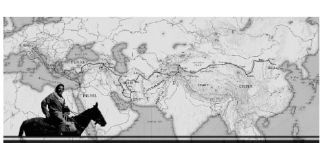Author/explorer/historian Harry Rutstein presents his new adventure memoir, chronicling the his trek in the footsteps of Marco Polo.
When thinking, reading or dreaming of travel, its hard to think of anything much more exotic or adventurous than the travels of the famed 13th century explorer Marco Polo.
Beginning when he was just a boy, it’s told that Polo accompanied his father, Niccolo, and uncle, Maffio, who were traveling Venetian merchants along trading posts throughout Italy and the Mediterranean, and into the Western reaches of the Mongol Empire and beyond.
In 1264, the trio is said to have joined with a Mongol embassy traveling to the seat of the Mongol ruler, Kublai Khan, grandson of Genghis Khan, the founder of the Mongols, the largest contiguous empire in history. And in effect, they became some of, if not the first European travelers to visit the far East along Asia’s Silk Road.
Marco Polo relates the experience in his book “Il Millione” — in English: ‘The Million’ — also referred to as “The Travels of Marco Polo” in English.
It’s a fantastic and epic journey, but the book and its travels have been highly debated given that the original text (purportedly written in a language Polo didn’t speak) is lost, leaving behind several, sometimes conflicting translated versions.
Enter: 20th century American author, explorer and historian Harry Rutstein, who will present be reading from his book “The Marco Polo Odyssey” at the next edition of the Bainbridge Island Library Travelogue series — tonight (Nov. 19) at 7:30 p.m.
In 1985, Rutstein became the first person in history known to have retraced Marco Polo’s recorded footsteps.
Over a period of 10 years on three different expeditions from 1975-1985, Rutstein retraced the routes of the 13th century explorer — a 13,000-mile voyage from Venice, Italy to Bejing, China — using “The Travels of Marco Polo” as his guide and every means available for transportation.
He wrote a book about it with one of his adventure companion and anthropologist JoAnne Kroll halfway through the journey in 1980 and published a film documentary in the Kindu Kush mountains called “On the Roof of the World with Marco Polo” in 1981.
In his new book “The Marco Polo Odyssey” — published fittingly on the anniversary of Marco Polo’s birthday, Sept. 18, 2008 — Rutstein recounts, and reflects on, the entire journey.
It started in early July 1975, Rutstein, his son Rich (who was 19, the same age as Marco Polo when he traveled to China with his father in 1264) and anthropologist Joanne Kroll departed Venice by boat for Israel then onto Turkey, across the two great deserts of Iran, across Afghanistan and on to the Hindu Kush mountains, where they were stopped by winter and no permission to cross into China.
“The big problem I had at that point was that I didn’t have a visa to get into China,” Rutstein said. “In 1949, they closed the borders.”
Marco Polo probably didn’t need a passport. For Rutstein, thus ended his first expedition, and began a near 12-year process in acquiring credentials to cross China’s western border.
During that time, Rutstein traveled back to the Hindu Kush to film “On the Roof of the World with Marco Polo,” while he finagled a way into China.
After being ignored by bureaucracy as simply an explorer retracing the route of Marco Polo, Rutstein found a Poloian solution by identifying himself as a merchant, an Asian representative for high-tech American companies. And the doors opened for his final expedition.
In “The Marco Polo Odyssey” Rutstein recounts that third expedition and matches pieces of Polo’s text with his modern-day descriptions of “details you would only know from being there,” he said, thus giving credence to the story of Marco Polo.



